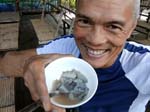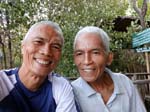
 Dec 18, 2016
Dec 18, 2016
Visiting the Bakhawan Eco-Park of Kalibo
Location ![]() : Bakhawan Eco-Park, New Buswang (barangay), Kalibo (municipality), Aklan (province), Philippines
: Bakhawan Eco-Park, New Buswang (barangay), Kalibo (municipality), Aklan (province), Philippines
Website - www.bakhawanmangroveforest.com
Email - bakhawanecopark@yahoo.com
Telephone - 036.262.7596 | 036.262.8862
Hours - 7am to 7pm
Not just Ati-Atihan
Aside from Ati-Atihan, not much is on Kalibo's tourism radar. But a visit to the Bakhawan Eco-Park adds one to the short list. Normally, a tour to a mangrove forest isn't all that exciting - you see the same thing for the length of time you do the tour. Bakhawan Eco-Park ups it up a notch.
Man-Made
What makes this mangrove forest unique is that it's man-made. Normally, there is already an existing mangrove forest and the government decides to make it an eco-tourism destination by adding facilities and amenities - sometimes, nothing at all. Bakhawan Eco-Park used to be just a muddy shore until the private sector (Kalibo Save the Mangroves Association, Inc. - KASAMA) intiated a mangrove reforestation program on a 50-hectare mudflat with the help of the local government in 1990. The program became successful and this forest has now expanded to 220 hectares.
Wooden Planks
Bakhawan Eco-Park is on the northern area of town were the river meets the sea. At the entrance, you pay the fees and begin the one-kilometer walk along a well-made wooden elevated plank about a meter wide. There are sheltered rest-stops for the challenged. Along the way are markers on how much longer to go. It's quiet and peaceful once inside the forest system.

resting on a humped bamboo bridge spanning the mainland to the mangrove island
Shaded Resto Stop
The end of the walk opens up to the sea with a sandbar in the foreground. There is also a welcoming resto rest area with lounge chairs facing the sea in a shaded area - very relaxing. Orders are limited to refreshments, halo-halo and the much talked-about tamilok.
Tamilok
Inside the rotting mangrove wood are edible worm-like creatures. Although grubs are common food to the aborigines of Australia, this is not part of our culture - so it's an experience to eat them. The wood is chopped open to reveal the inside of the wood where the tamilok hides. They live in the wood all their lives. They are pulled from the wood, the head and tail removed, and the insides are opened up to be cleaned. They are then put in a bowl and the flavored vinegar, sinamak is poured over. You eat it as is - no cooking. I had a bowl-full. The texture and consistency is like oysters...thin oysters. Yes, it was yummy with ice cold beer!
Livelihood
The mangrove forest, the resto area and the tamilok offering has become a tourist attraction and generates a livelihood to the locals. They also get to harvest crabs living in the mangroves. By benefiting from the mangrove, they now become the stewards. Instead of cutting them down for charcoal sale, they police themselves to protect the mangroves. Everybody wins - the birds, crabs, the locals and the environment!
Mr. Pablito Isturya
The patriarch of the related locals managing the resto stop is Mr. Pablito. He's 68 years old, he is lone surviving worker on the mangrove - 26 years, right from the start! We had a good long conversation, sharing insight and anecdotes. He was a highlight of the trip for me...and the tamilok!
Ending Thoughts
In this country, mangrove forests are usually decimated by people who cut them down to make charcoal to sell to purveyors of lechon manok or lechon baboy. This practice kills an entire ecosystem and renders the place vulnerable to erosion into the sea and typhoon onslaught.
By planting mangroves, they develop a new environment that spawns new flora and fauna. And by developing a comfortable resto stop that opens up to a sea view where one can have a cold refreshment or an exotic food after a kilometer of walking, they make the place a tourist destination that makes the whole enterprise viable - not a novelty that soon comes to a halt when budget dries up. This is a perfect example of eco-tourism. I hope this becomes a model for all the mangrove forests we have in the country.
--- Gigit (TheLoneRider)
YOGA by Gigit ![]() |
Learn English
|
Learn English ![]() |
Travel like a Nomad
|
Travel like a Nomad ![]() |
Donation Bank
|
Donation Bank ![]()
Bakhawan Eco-Park Cost Index
(US$1 = Php 52 as of Apr 25, 2022)- PHP 50 ceiling for tricycle ride from town center to eco park - they could charge as much as P100!
- PHP 150 entrance fee
- PHP 500 cabana rental
- PHP 250 starting rate for kayak rental
- PHP 50/pax river crossing to the sandbar by bamboo raft, min 4 pax
- PHP 300 serving of tamilok including demo on how it is taken from the wood
- PHP 65 San Miguel Beer
Bakhawan Eco-Park FYI / Tips
- no need to make the tricycle driver wait for you. It's easy to get a ride back
How to Get to Bakhawan Eco-Park from town center or Plaza
- take a tricycle anywhere from the main town, P30-40/pax, 15 min
Leave a comment?
Next Traveling story:

![]()
Climbing Tigayon Hill of Kalibo
(Dec 21, 2016) 3 kilometers from the town center is the only hill in Kalibo, Tigayon Hill. It is a limestone outcropping with 2 caves and serves as a spiritual pilgrimage site during Holy Week. It's supposed to be a viewpoint for the river but the top has too many trees to enjoy a view with.....more »»
 Kalibo, Philippines
Kalibo, Philippines
 Kalibo International Airport - the gateway to Boracay via Kalibo
Kalibo International Airport - the gateway to Boracay via Kalibo Gaisano Capital Kalibo - the go-to mall in Kalibo
Gaisano Capital Kalibo - the go-to mall in Kalibo City Mall - latest mall offering
City Mall - latest mall offering
 Bakhawan Ecopark - mangrove forest on the outskirt of Kalibo with a 1.3-kilometer bamboo trail | 11°43'12.1"N 122°23'27.9"E
Bakhawan Ecopark - mangrove forest on the outskirt of Kalibo with a 1.3-kilometer bamboo trail | 11°43'12.1"N 122°23'27.9"E Museo It Akean - history, culture and tradition of Aklan
Museo It Akean - history, culture and tradition of Aklan Tigayon Hill in Kalibo - 2 caves, rock formations on a hill with a view of the river, free admission | 11°40'32.9"N 122°20'29.4"E
Tigayon Hill in Kalibo - 2 caves, rock formations on a hill with a view of the river, free admission | 11°40'32.9"N 122°20'29.4"E Finds Museum Kalibo - rare collection of Asian fine arts, stamps, antiques, gems | 11°41'56.0"N 122°22'03.4"E
Finds Museum Kalibo - rare collection of Asian fine arts, stamps, antiques, gems | 11°41'56.0"N 122°22'03.4"E
 Marzon Hotel - near airport, swimming pool, latte restaurant
Marzon Hotel - near airport, swimming pool, latte restaurant
Jaime Cardinal Sin Ave., Andagao, Kalibo, Aklan
+63.36.268.2188 | +63.36.268.2184 | +63 917.321.0011 | +63 939.925.9008
°11°41'46.7"N 122°22'23.5"E | reservation@marzonhotelkalibo.com
Kalibo FYI / Tips
- the center of town is at the Plaza where you have the Pastrana Park and Cathedral
- no movie house in Kalibo
- no inter-town jeeps or bus...just tricycles
How to Get to Kalibo
- from Boracay - usually, it's the other way around. People go to Boracay via Kalibo airport because air fare is cheaper in Kalibo rather than Caticlan. But from Boracay, take any Ceres bus heading south for Iloilo via Kalibo (not Pandan) and you get off the main terminal in Kalibo.
- from Iloilo - any Iloilo bus heading for Boracay will pass by Kalibo
Local Aklanon Food to Try
- tamilok - grubs taken from decaying wood - looks like worms, best with vinegar, eaten raw
- binakoe - native chicken in thick sauce inside a bamboo
- Inubarang manok - chicken simmered in coconut
- Linapay or Tinamuk - river shrimp cooked in coconut milk
Kalibo Cost Index
(US$1 = Php 52 as of Apr 25, 2022)Kalibo is still inexpensive and the dollar goes a long way specially with food. Lodging though, compared to Cambodia or Thailand is expensive.
- PHP 30-120 platter of oysters in a bar
- PHP 8 minimum tricycle tariff
- PHP 80 coffee in a trendy cafe
Kalibo Blogs by TheLoneRider
- Visiting the Finds Museum in Kalibo Dec 21, 2016
- Climbing Tigayon Hill of Kalibo Dec 21, 2016
- Visiting the Bakhawan Eco-Park of Kalibo Dec 18, 2016
- Defaulting to Kalibo, Aklan Dec 17, 2016
Suggested itinerary on the WEST coast of Panay Island from Boracay going south
- Boracay - most popular beach in the Philippines
- Malay - Nabaoy River, Pangihan Cave, Nagata Falls, Agnaga Falls, Naasug Point, Malay Ecological Park, Motag Living Museum
- Nabas - wind tubines, Hurom-Hurom Cold Springs
- Pandan - Malumpati Spring
- Libertad - Maanghit Cave, Ati Cave and Bungan-Bungan Spring
- Sebaste - Igpasungaw Waterfall
- Culasi - Malalison Island
- Tibiao - hot kawa-bath, white water river rafting, Bugtong Bato Waterfall, rice terraces, Tibiao Bakery, pottery, fish spa
- Anini-y - Nogas Island, scuba diving
Suggested itinerary on the EAST coast of Panay Island from Boracay going south
- Boracay - most popular beach in the Philippines
- Malay - Nabaoy River, Pangihan Cave, Nagata Falls, Agnaga Falls, Naasug Point, Malay Ecological Park, Motag Living Museum
- Nabas - wind tubines, Hurom-Hurom Cold Springs
- Kalibo - Bakhawan Eco-Park, Tigayon Hill
- Tambak - oysters
- Capiz - Roxas City
- Carles | Estancia - Gigantes Island Boat Tour, Lighthouse of Gigantes Island and Bakwitan Cave of Gigantes Island
- Iloilo - Batchoy Indulgence
Currency Converter
»» next Traveling story: Climbing Tigayon Hill of Kalibo
»» back to Traveling
»» back to Homepage
ARCHIVE 2025:
JAN |
FEB |
MAR
1970 |
1973 |
1975 |
1976 |
1977 |
1979 |
1981 |
1996 |
2000 |
2001 |
2002 |
2003 |
2004 |
2005 |
2006 |
2007 |
2008 |
2009 |
2010 |
2011 |
2012 |
2013 |
2014 |
2015 |
2016 |
2017 |
2018 |
2019 |
2020 |
2021 |
2022 |
2023 |
2024 |
2025 |
ALL BLOGS




































